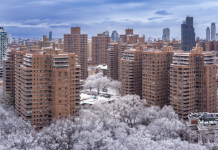
Community Board 3 is poised to join a local effort to rezone a section of the Two Bridges area, part of a larger campaign to stop three gigantic towers from going up on the waterfront. CB3’s land use committee voted unanimously last night to become a co-applicant of the zoning proposal. The full board is certain to follow the committee’s lead later this month.
The initiative is being led by the Two Bridges resident coalition known as TUFF-LES, Good Old Lower East Side (GOLES) and CAAAV-Organizing Asian Communities. They are working with the Urban Justice Center to move the proposal through the city bureaucracy.
The community board’s support is essential, not just because CB3’s endorsement of the plan will give it credibility with the Department of City Planning. The board’s involvement as a co-applicant also means the city will waive a $500,000 in fees normally required.
At last night’s meeting, City Council member Margaret Chin spoke in favor of the effort. On Oct. 12, she and Manhattan Borough President Gale Brewer submitted a request to the city for a zoning text amendment. It would require the developers of the three proposed mega-towers to obtain special permits, which would trigger a full land use review (ULURP) for the sites.
Chin said she’s confident her strategy to “stop these towers from going forward” will succeed, but added, “We need to go further to protect our neighborhood. This is why this community-led effort to rezone the waterfront has my full support and when there is community consensus I am not afraid to take on the administration. So I hope that the proposal discussed today will move forward through the community board, so we can get the protection we need as quickly as possible.”

In a brief presentation, representatives from the community groups explained what they’re trying to accomplish. Their starting point is the 2014 Chinatown Working Group (CWG) Plan, a community-led initiative that called for rezoning a wide swathe of the Lower East Side and Chinatown.
The local groups are now pulling out a section of the plan, known as Sub-District D, for the potential rezoning. The sub-district covers the waterfront between Catherine Slip all the way up to East 13th St. They’re focused first and foremost on stopping the proposed projects, which include a 1,008 foot building from JDS Development Group at 247 Cherry St.; 62 and 69 story towers from L+M Development Partners and the CIM Group at 260 South St.; and a 62-story building by the Starrett Group at 259 Clinton St. The sites are located in a C6-4 zoning district, which is reserved high-bulk commercial uses and high density housing.
The CWG Plan imposes a 350-foot height cap (35 stories), up to 55% permanent affordable housing in new developments and requires special permits for big box stores and nightlife establishments.

Several members of the land use committee voiced skepticism about some of the details, but everyone agreed on the critical need for new zoning on the waterfront. An influential board member, Lisa Kaplan, noted that she opposed the proposal for Sub-District D a couple of years ago. Last night, however, she said, “I’ve changed my mind. I have real reservations about some of the aspects of this (proposal). I think it’s unrealistic. But I think, at this point, we have to be negotiating (with the city)… The proposal on the floor (from the developers) is so outrageous and so out of scale that we have to sit down and we have to be part of a discussion about reconsidering this area.”
Committee members said they want a plan that has a chance of making through the City Planning Commission. They believe this will mean, among other things, reducing the size of Sub-District D and settling for less affordable housing. The applicants said they understood that not every part of the original CWG Plan, which was finalized three years ago, can be implemented.
The community board is expected to sign on as a co-applicant with the understanding that CB3 representatives will be included in negotiation sessions with city officials. If the proposal moves forward, it would be subject to the city’s Uniform Land Use Review Procedure (ULURP), which includes community board hearings, an advisory opinion from the borough president, approval by the City Planning Commission and a vote in the City Council.
Time is of the essence. Neighborhood rezonings take months (sometimes years) to go through ULURP. The City Planning Commission is now evaluating a joint environmental review of the towers and has been expected to vote on the projects before the end of this year. Rezonings can be implemented even after work begins on building foundations, but the applicants know they must move quickly if they’re going to stop the mega-towers.
In the past, city officials have discouraged any rezoning in the Two Bridges area. Now, however, there appears to be at least some willingness to talk about the issue. A spokesperson at the Department of City Planning told The Lo-Down this afternoon, “If CB3 and local groups request an informational meeting regarding a land use application, DCP will be available.”
The development teams declined to comment on the rezoning proposal. They did, however, have this to say about their projects:
From the outset, and after consultation with the City and elected officials, all three development teams have committed to providing 25 percent of the proposed unit count as permanently affordable housing, which would result in the creation of nearly 700 permanently affordable apartments – one of the largest infusions of affordable housing in Manhattan in recent decades. We fully intend to formalize that commitment before the conclusion of the approval process. We appreciate that the current process has provided multiple opportunities for robust community input, including through four productive feedback sessions and ongoing discussions with neighborhood leaders. We will look forward to continuing that dialogue, and to discussing the substantial upgrades proposed for neighborhood flood resiliency, open space and retail opportunities with local stakeholders as the process moves forward.
Trever Holland, a tenant leader in the Two Bridges area, expressed relief that efforts are now underway to protect the neighborhood. Last night, though, he voiced some frustration that it’s taken so long. Holland, a member of Community Board 3, said he’s begged and pleaded for help on more occasions than he can count. Members of other community boards, he said, ask him, “What is your community board doing right now? If there’s something they could do, why aren’t they doing it?” Holland concluded, “This is an opportunity for our community board to do something.”
MyPhuong Chung, land use committee chair, apparently did not care for Holland’s comments. Several minutes later, she defended her committee’s efforts on behalf of the Two Bridges neighborhood. “It kind of sounds like we’ve just been sitting on our hands this whole time,” said Chung, “and ignoring this — and that couldn’t be further from the truth.”
Chung added, “I personally played a part in leading this plan (as a representative on the Chinatown Working Group). So I think it’s irresponsible to paint the land use committee as not caring about this issue. We voted twice and got rejected twice from City Planning (regarding subdistrict D). We did that, I think, at great risk to this community board’s credibility. It’s not that we haven’t tried, but we’re willing to work with you going forward, especially since so many things have changed, even in the last two years since we officially took a vote on this area.”

A huge crowd turned out last night for the zoning presentation. During a public speaking session, a number of people criticized the community groups for moving forward with a single section of the Chinatown Working Group Plan. There was particular concern about the impact of a rezoning on parcels owned by the New York City Housing Authority. [NYCHA is already moving forward with a new mixed-income tower on a parking lot adjacent to the LaGuardia Houses.]
Over the years, some local activists have labeled any effort to prioritize one section of the community over another “racist” and exclusionary. The city rejected the full plan, calling it too expansive. As a result, the CWG Plan has languished. Interestingly, two of the groups behind the new effort to move ahead with Sub-District D, GOLES and CAAAV, are among those organizations that previously opposed a piecemeal approach.
The community board is trying to move forward with rezoning the other sub-districts. CB3 Chair Jamie Rogers told us today, “We hope to engage the Chinatown community through the Chinatown Neighborhood Planning Subcommittee and are working with DCP to secure a facilitator to help with the committee’s work.” Rogers said the board is also committed to “protecting the NYCHA campuses,” using the guidelines set forth in the Chinatown Working Group Plan. A city spokesperson reiterated today that, “DCP is open to discussions with community and elected officials regarding a planning process for the Chinatown core (an area that is undefined but likely to include the historic heart of Chinatown only).”
Rezoning the Waterfront by The Lo-Down on Scribd









